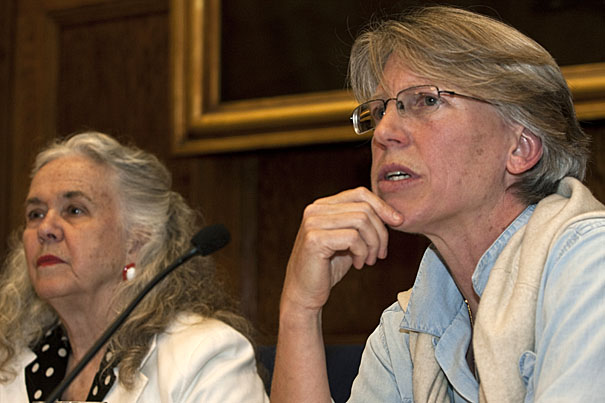
C.S. Manegold (right), a visiting senior lecturer in English at Mt. Holyoke College, speaks about her book, “Ten Hills Farm: The Forgotten History of Slavery in the North.”
Jon Chase/Harvard Staff Photographer
Slavery in the North, and more
Du Bois Institute hosts fellows’ book party
When writer and reporter C.S. Manegold was in South Carolina researching slavery and The Citadel military college for her first book, she unwittingly found the unexpected subject for her second book.
“People kept asking me about slavery in the North,” she recalled. The former Du Bois Institute fellow said that she grew angry about her lack of knowledge of Northern slavery, and that her book, “Ten Hills Farm: The Forgotten History of Slavery in the North,” grew from that anger.
At a book party celebrating former and current Du Bois fellows’ recent publications, Manegold and an all-female panel of authors spoke about their research that weaves race and African-American progress with topics such as art and beauty, to more familiar terrain such as the National Association for the Advancement of Colored People’s (NAACP) influence and the Tuskegee syphilis experiments.
Manegold said that people customarily associate the South with slavery, but that many people are “shocked and completely unaware” about its presence in the North, particularly earlier in America’s history, and that she “wanted to write something that would pierce the public consciousness.”
“Ten Hills Farm” does just that, tracing the history of the Royall House, a 600-acre estate north of Boston that straddles the Medford and Somerville border. Founded in 1638 by John Winthrop, then-governor of Massachusetts Bay Colony, the estate was purchased in 1732 by merchant and slave trader Isaac Royall, who brought with him 27 slaves from Antigua.
Manegold said that slavery was never more than 3 percent of the population in New England, but, she told the audience: “I would encourage you never to fall into the pattern of thinking it was somehow benign or inherently different from slavery in the South.”
Photographer and current Du Bois fellow Deborah Willis, professor and chair of the Department of Photography and Imaging at New York University’s Tisch School of the Arts, spoke about her book “Posing Beauty: African American Images from the 1890s to the Present.” Examining photography, film, and video, her book, Willis said, explores the “contested ways in which African and African-American beauty has been represented in historical and contemporary ways and contexts.”
“I considered the Western history of art, in terms of how image-making and the relationship between beauty and art has become increasingly complex in contemporary art and pop culture,” said Willis.
Writer Patricia Hills, professor of art history at Boston University, also discusses art in her chronicling of well-known 20th century African-American artist Jacob Lawrence. Her book, “Painting Harlem Modern: The Art of Jacob Lawrence,” dissects his cubist paintings, and the social and political goings-on that inspired his work.
Susan Reverby’s “Examining Tuskegee: The Infamous Syphilis Study and Its Legacy” retells the history of the study of late-stage syphilis in African-American men in Alabama, while uncovering new truths with the recent availability of the Tuskegee patients’ medical records, and examining how the study became a cultural icon.
Reverby, a professor at Wellesley College, said the name “Tuskegee,” even 40 years after the study ended, “evokes fears of the dangers of government involvement in medical care and has gained great metaphorical and signifying power.” She likened Tuskegee to the collective apprehension surrounding the recent swine flu vaccine.
“My book is a plea for understanding what was intended to happen, and what I think actually happened on the ground,” said Reverby. “It’s a call for remembering the noble facts in the study, and I hope that we no longer need Tuskegee as a metaphor for injustice.”
Evelyn Brooks Higginbotham, Victor S. Thomas Professor of History and of African and African American Studies and department chair of African and African American Studies, was a Du Bois fellow prior to 1992. Her latest endeavor is a rewrite of the revered “From Slavery to Freedom: A History of African Americans” by John Hope Franklin.
Franklin died after charging Higginbotham with the task of updating the tome, which received its most prominent revision with a new chapter dedicated to the election of President Barack Obama. “I would not have ever imagined writing that chapter two years ago,” said Higginbotham.
While all of the scholars’ research and publications paid honor to W.E.B. Du Bois, a key leader on African-American rights and their fellowship’s namesake, Patricia Sullivan wrote about the founding and unlikely growth of the NAACP, which was co-founded in 1909 by a group that included Du Bois.
In “Lift Every Voice: The NAACP and the Making of the Civil Rights Movement,” Sullivan, an associate professor of history at the University of South Carolina, said that the groundbreaking organization nearly didn’t succeed.
Noting that money woes threatened the NAACP at every turn, Sullivan called the fledgling organization a “lean, improvisational enterprise dependent on the talent and dedication of a handful of men and women and a growing network of volunteers who built the organization from the ground up.”
Acknowledging the NAACP’s landmark legal victories — including Brown v. Board of Education, the Supreme Court case ruling that outlawed school segregation — Sullivan said the organization empowered African Americans to work to eliminate segregation in America.
“And that’s where our sit-ins and freedom rights came from.”




